职业高中英语第三册第四单元语法部分教案unit 4 langguage in use
- 格式:doc
- 大小:50.54 KB
- 文档页数:5
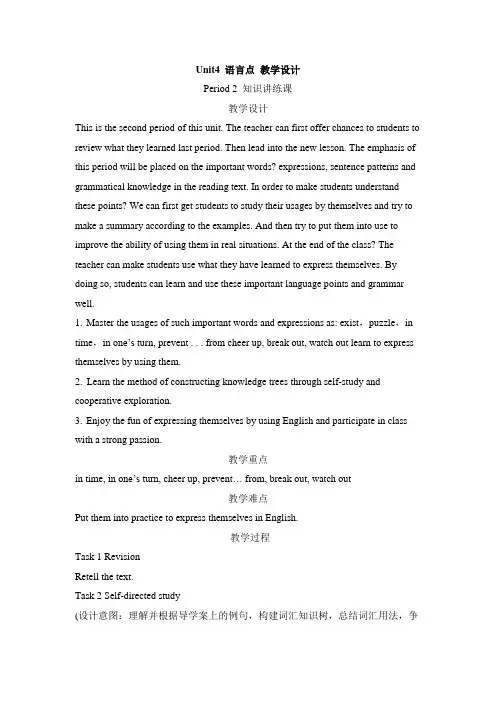
Unit4 语言点教学设计Period 2 知识讲练课教学设计This is the second period of this unit. The teacher can first offer chances to students to review what they learned last period. Then lead into the new lesson. The emphasis of this period will be placed on the important words? expressions, sentence patterns and grammatical knowledge in the reading text. In order to make students understand these points? We can first get students to study their usages by themselves and try to make a summary according to the examples. And then try to put them into use to improve the ability of using them in real situations. At the end of the class? The teacher can make students use what they have learned to express themselves. By doing so, students can learn and use these important language points and grammar well.1. Master the usages of such important words and expressions as: exist,puzzle,in time,in one’s turn, prevent . . . from cheer up, break out, watch out learn to express themselves by using them.2. Learn the method of constructing knowledge trees through self-study and cooperative exploration.3. Enjoy the fun of expressing themselves by using English and participate in class with a strong passion.教学重点in time, in one’s turn, cheer up, prevent… from, break out, watch out教学难点Put them into practice to express themselves in English.教学过程Task 1 RevisionRetell the text.Task 2 Self-directed study(设计意图:理解并根据导学案上的例句,构建词汇知识树,总结词汇用法,争取新旧知识联系,培养自主学习能力。

Unit 4 I’d like to return this jacket because it doesn’t fit my husband.一、单元内容分析本单元的教学重点是掌握关于投诉的词汇与短语。
能够听懂谈及投诉相关话题的对话;正确并熟练运用英语进行投诉的相关表达与句型;能读懂简单的投诉信的短文。
本单元通过呈现生活场景图片,引出投诉这个话题,与学生的生活联系紧密。
学生在以前的学习中对本单元的词汇和短语有少量接触,针对学生的实际情况,教师应该通过合理的设计,帮助学生有效地完成听、说、读、写四个任务,为后面的练习以及语言的输出做好充足的准备。
在教学过程中教师可充分利用图片或设定场景给出语境,让学生在个体或集体活动中充分练习投诉的相关句型。
并在此基础上培养学生具备初步的服务意识,能够以合理的方式处理顾客投诉。
本单元设计成四个课时:第一课时Lead-in + Listening and speaking第二课时Reading and writing第三课时Language in use第四课时V ocabulary practice + Supplementary Reading二、分课时教学设计第一课时Lead-in + Listening and speaking一、教材分析1.教学内容本课时系教材《英语基础教程》(3)第四单元的第一课时,包括Lead-in & Listening and speaking两部分,具体内容为:学习投诉的词汇与短语,听懂并掌握投诉的简单对话,能使用相关句型清楚地描述商品问题并寻求解决办法。
2.教学重点、难点(1)教学重点学习投诉的词汇与短语;听懂投诉的句型;听懂投诉的简单对话。
(2)教学难点掌握投诉的句型;能使用相关句型清楚地描述商品问题并寻求解决办法。
二、教学目标1.知识目标(1)学习并识记投诉的词汇与短语,如:exchange; detail; receipt; record; refund; credit note(2)学会并能套用投诉的句型,如:I’d like to return/exchange……because……Would you please show me your receipt so that……You can exchange it/get a refund.Do you have another……?I’ll come back later and see if ……2.能力目标(1)能听懂关于投诉的对话。
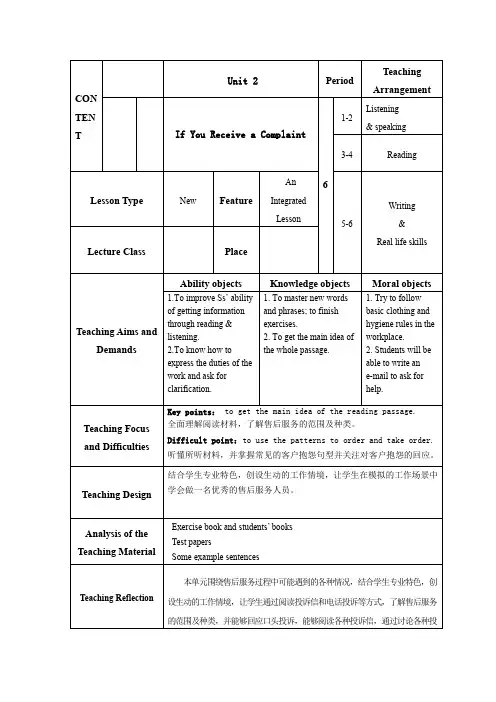
CON TEN TUnit 2 PeriodTeachingArrangement If You Receive a Complaint61-2Listening& speaking3-4 ReadingLesson Type New FeatureAnIntegratedLesson5-6Writing&Real life skillsLecture Class PlaceTeaching Aims and DemandsAbility objects Knowledge objects Moral objects 1.To improve Ss’ abilityof getting informationthrough reading &listening.2.To know how toexpress the duties of thework and ask forclarification.1. To master new wordsand phrases; to finishexercises.2. To get the main idea ofthe whole passage.1. Try to followbasic clothing andhygiene rules in theworkplace.2. Students will beable to write ane-mail to ask forhelp.Teaching Focus and Difficulties Key points: to get the main idea of the reading passage.全面理解阅读材料,了解售后服务的范围及种类。
Difficult point:to use the patterns to order and take order. 听懂所听材料,并掌握常见的客户抱怨句型并关注对客户抱怨的回应。
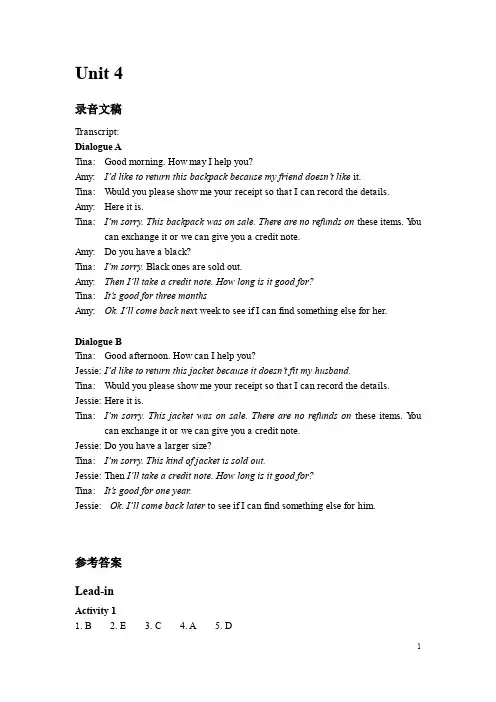
Unit 4录音文稿Transcript:Dialogue ATina: Good morning. How may I help you?Amy: I’d like to return this backpack because my friend doesn’t like it.Tina: Would you please show me your receipt so that I can record the details. Amy: Here it is.Tina: I’m sorry. This backpack was on sale. There are no refunds on these items. You can exchange it or we can give you a credit note.Amy: Do you have a black?Tina: I’m sorry. Black ones are sold out.Amy: Then I’ll take a credit note. How long is it good for?Tina: It’s good for three monthsAmy: Ok. I’ll come back nex t week to see if I can find something else for her.Dialogue BTina: Good afternoon. How can I help you?Jessie: I’d like to return this jacket because it doesn’t fit my husband.Tina: Would you please show me your receipt so that I can record the details. Jessie: Here it is.Tina: I’m sorry. This jacket was on sale. There are no refunds on these items. You can exchange it or we can give you a credit note.Jessie: Do you have a larger size?Tina: I’m sorry. This kind of jacket is sold out.Jessie: Then I’ll take a credit note. How long is it good for?Tina: It’s good for one year.Jessie: Ok. I’ll come back later to see if I can find something else for him.参考答案Lead-inActivity 11.B2. E3. C4. A5. DListening and SpeakingActivity 2□To return the backpack.Activity 31. a2. b3. dActivity 41. I’d like to return this backpack because my friend doesn’t like it2. Would you please show me your receipt so that I can record the details?3. This backpack was on sale. There are no refunds on these items.4. You can exchange it or we can give you a credit note.Activity 5(略)Activity 6(略)Reading and WritingActivity 7(略)Activity 8Ryan选用的投诉方式:Write a Letter of ComplaintRyan投诉的原因:1.Firstly, according to your website, delivery takes seven days, but in fact it took over three weeks.2.To make matters worse, it is the wrong model.3.In addition, the deliveryman was really rude to us.Ryan希望如何得到解决:Therefore, I would like to ask for an explanation.Activity 91. C2. C3. B4. AActivity 101. Ryan is writing to express his disappointment with delivery service.2. Ryan had to explain to his father on his birthday the delay of delivery.3. Ryan received a running machine TZ-7000 instead of TZ-9000.4. The Customer Service Manager would like to apologize for the inconvenience and disappointment.Activity 11Dear Sir / Madam,I am writing to complain about the quality of the computer.On July 20th 2016, I visited your website and ordered a computer. To my disappointment, there is something wrong with it. It often turns itself off.This problem is unaccep table. Therefore, I’d like to return this computer because it doesn’t work well.I’m looking forward to your response. Please contact me at(021)51375799 or e-mail me at yanyi@.Yours sincerely,Yan YiLanguage in UseActivity 121. a2. b3. a4. aActivity 131. d2. e3. c4. a5. bActivity 14Dear Miss Yang,Thank you for your letter so that we could provide the best solution to your problems as soon as possible. We would like to apologize for the inconvenience and disappointment that you experienced recently.We’ve informed the delivery department to deliver the right product to your house within 2 days. At the same time, we guarantee that the packing must be wrapped well. We would also like to offer you a 20% discount and a free gift.Once again, please accept our sincere apologies. We are looking forward to serving you again.Sincerely,Jake WhiteCustomer Service ManagerActivity 151. b2. d3. c4. aActivity 16return a stained backpackrecord detailsvisit a websitepay for this dinneroffer a discountActivity 171. cover; with2. apologize; for3. According to4. instead of5. explained6. expressSupplementary ReadingRead and decide.1. F2. F3. F4. TRead and answer.1. It aims to protect the customers’ right.2. There are four useful tips on how to protect rights.3. 略本单元语法总结1. 原因状语从句引导原因状语从句的连词有because,since,as,for。
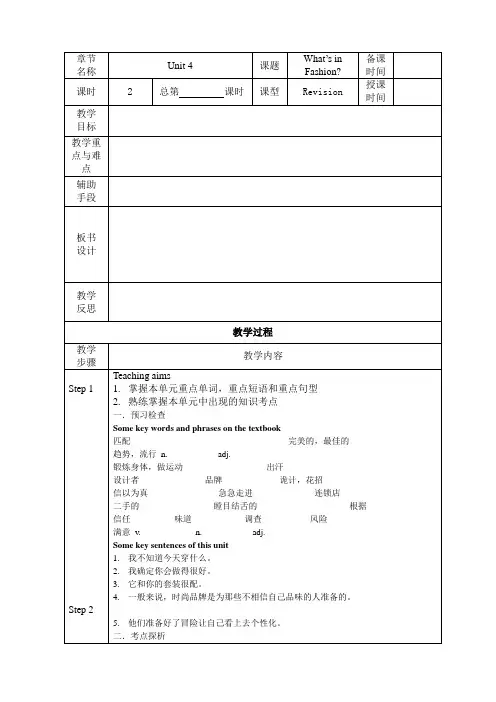
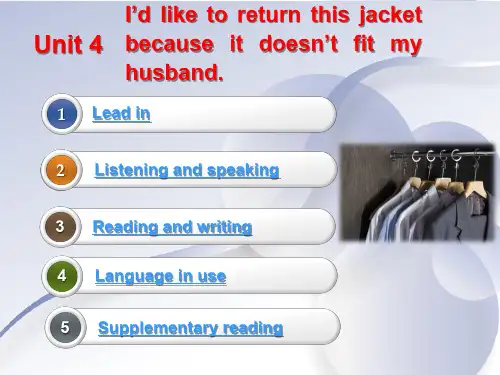
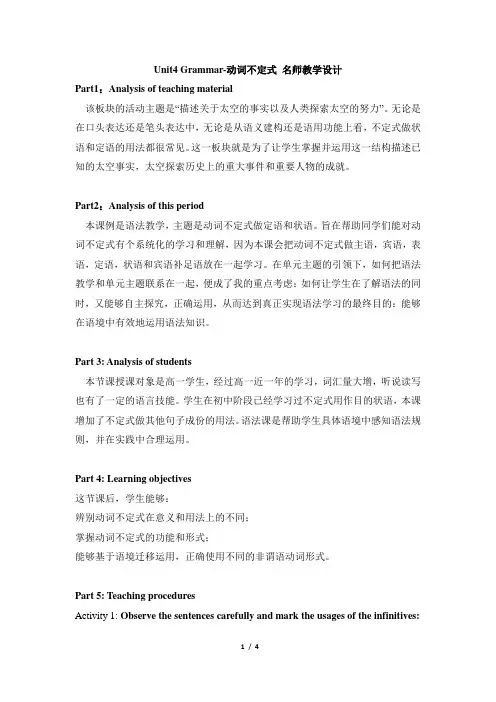
Unit4 Grammar-动词不定式名师教学设计Part1:Analysis of teaching material该板块的活动主题是“描述关于太空的事实以及人类探索太空的努力”。
无论是在口头表达还是笔头表达中,无论是从语义建构还是语用功能上看,不定式做状语和定语的用法都很常见。
这一板块就是为了让学生掌握并运用这一结构描述已知的太空事实,太空探索历史上的重大事件和重要人物的成就。
Part2:Analysis of this period本课例是语法教学,主题是动词不定式做定语和状语。
旨在帮助同学们能对动词不定式有个系统化的学习和理解,因为本课会把动词不定式做主语,宾语,表语,定语,状语和宾语补足语放在一起学习。
在单元主题的引领下,如何把语法教学和单元主题联系在一起,便成了我的重点考虑:如何让学生在了解语法的同时,又能够自主探究,正确运用,从而达到真正实现语法学习的最终目的:能够在语境中有效地运用语法知识。
Part 3: Analysis of students本节课授课对象是高一学生,经过高一近一年的学习,词汇量大增,听说读写也有了一定的语言技能。
学生在初中阶段已经学习过不定式用作目的状语,本课增加了不定式做其他句子成份的用法。
语法课是帮助学生具体语境中感知语法规则,并在实践中合理运用。
Part 4: Learning objectives这节课后,学生能够:辨别动词不定式在意义和用法上的不同;掌握动词不定式的功能和形式;能够基于语境迁移运用,正确使用不同的非谓语动词形式。
Part 5: Teaching proceduresActivity 1: Observe the sentences carefully and mark the usages of the infinitives:1. It is an important skill to learn to think critically. (2019天津) ___________2. But some students didn’t want to wear the uniform. (2019浙江)___________3. My ambition is to work for a firm that develops computer software.___________4. These disasters made everyone sad and disappointed, but the desire to explore the universe never died.___________5. You must be intelligent enough to get a related college degree.___________6. Parents should actively urge their children to take advantage of the opportunity to join sports teams. (2016江苏)___________Activity 2: Focus on talking about the different functions of the infinitives.1. As subject①To keep smiling is healthy for you.②It took him a long time to acquire the skills he needed to become a good dancer. 注意:◆单个不定式作主语时,谓语动词用______。
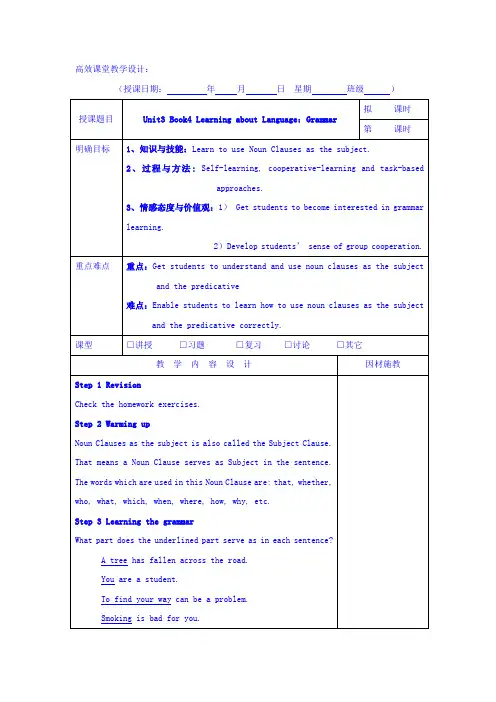
高效课堂教学设计:(授课日期:年月日星期班级)品味人生1、不管鸟的翅膀多么完美,如果不凭借空气,鸟就永远飞不到高空。
想象力是翅膀,客观实际是空气,只有两方面紧密结合,才能取得显着成绩。
2、想停下来深情地沉湎一番,怎奈行驶的船却没有铁锚;想回过头去重温旧梦,怎奈身后早已没有了归途。
因为时间的钟摆一刻也不曾停顿过,所以生命便赋予我们将在汹涌的大潮之中不停地颠簸。
3、真正痛苦的人,却在笑脸的背后,流着别人无法知道的眼泪,生活中我们笑得比谁都开心,可是当所有的人潮散去的时候,我们比谁都落寂。
4、温暖是飘飘洒洒的春雨;温暖是写在脸上的笑影;温暖是义无反顾的响应;温暖是一丝不苟的配合。
5、幸福,是一种人生的感悟,一种个人的体验。
也许,幸福是你风尘仆仆走进家门时亲切的笑脸;也许,幸福是你卧病床上百无聊赖时温馨的问候;也许,幸福是你屡遭挫折心灰意冷时劝慰的话语;也许,幸福是你历经艰辛获得成功时赞赏的掌声。
关键的是,你要有一副热爱生活的心肠,要有一个积极奋进的目标,要有一种矢志不渝的追求。
这样,你才能感受到幸福。
6、母爱是迷惘时苦口婆心的规劝;母爱是远行时一声殷切的叮咛;母爱是孤苦无助时慈祥的微笑。
7、淡淡素笺,浓浓墨韵,典雅的文字,浸染尘世情怀;悠悠岁月,袅袅茶香,别致的杯盏,盛满诗样芳华;云淡风轻,捧茗品文,灵动的音符,吟唱温馨暖语;春花秋月,红尘阡陌,放飞的思绪,漫过四季如歌。
读一段美文,品一盏香茗,听一曲琴音,拾一抹心情。
8、尘缘飞花,人去楼空,梦里花落为谁痛?顾眸流盼,几许痴缠。
把自己揉入了轮回里,忆起,在曾相逢的梦里;别离,在泪眼迷朦的花落间;心碎,在指尖的苍白中;淡落,在亘古的残梦中。
在夜莺凄凉的叹息里,让片片细腻的柔情,哽咽失语在暗夜的诗句里。
9、用不朽的“人”字支撑起来的美好风景,既有“虽体解吾犹未变兮”的执着吟哦,也有“我辈岂是蓬蒿人”的跌宕胸怀;既有“我以我血荐轩辕”的崇高追求,也有“敢教日月换新天”的豪放气魄。
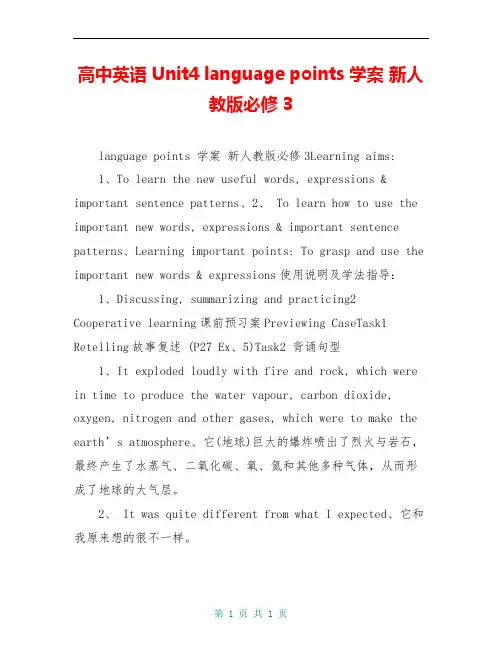
高中英语 Unit4 language points 学案新人教版必修3language points 学案新人教版必修3Learning aims:1、To learn the new useful words, expressions & important sentence patterns、2、 To learn how to use the important new words, expressions & important sentence patterns、Learning important points: To grasp and use the important new words & expressions使用说明及学法指导:1、Discussing, summarizing and practicing2 Cooperative learning课前预习案Previewing CaseTask1 Retelling故事复述 (P27 Ex、5)Task2 背诵句型1、It exploded loudly with fire and rock, which were in time to produce the water vapour, carbon dioxide, oxygen, nitrogen and other gases, which were to make the earth’s atmosphere、它(地球)巨大的爆炸喷出了烈火与岩石,最终产生了水蒸气、二氧化碳、氧、氮和其他多种气体,从而形成了地球的大气层。
2、 It was quite different from what I expected、它和我原来想的很不一样。
3、 This made it possible for us to learn English better、这使得我们有可能把英语学得更好。
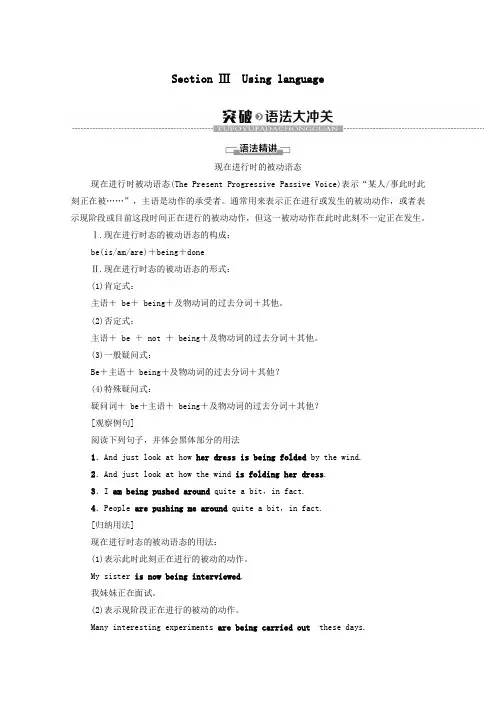
Section ⅢUsing language现在进行时的被动语态现在进行时被动语态(The Present Progressive Passive Voice)表示“某人/事此时此刻正在被……”,主语是动作的承受者。
通常用来表示正在进行或发生的被动动作,或者表示现阶段或目前这段时间正在进行的被动动作,但这一被动动作在此时此刻不一定正在发生。
Ⅰ.现在进行时态的被动语态的构成:be(is/am/are)+being+doneⅡ.现在进行时态的被动语态的形式:(1)肯定式:主语+ be+ being+及物动词的过去分词+其他。
(2)否定式:主语+ be + not + being+及物动词的过去分词+其他。
(3)一般疑问式:Be+主语+ being+及物动词的过去分词+其他?(4)特殊疑问式:疑问词+ be+主语+ being+及物动词的过去分词+其他?[观察例句]阅读下列句子,并体会黑体部分的用法1.And just look at how her dress is being folded by the wind.2.And just look at how the wind is folding her dress.3.I am being pushed around quite a bit,in fact.4.People are pushing me around quite a bit,in fact.[归纳用法]现在进行时态的被动语态的用法:(1)表示此时此刻正在进行的被动的动作。
My sister is now being interviewed.我妹妹正在面试。
(2)表示现阶段正在进行的被动的动作。
Many interesting experiments are being carried out these days.这些天正在进行着许多有趣的实验。
(说话时,并不一定正在进行)(3)表示反复进行的被动的动作。
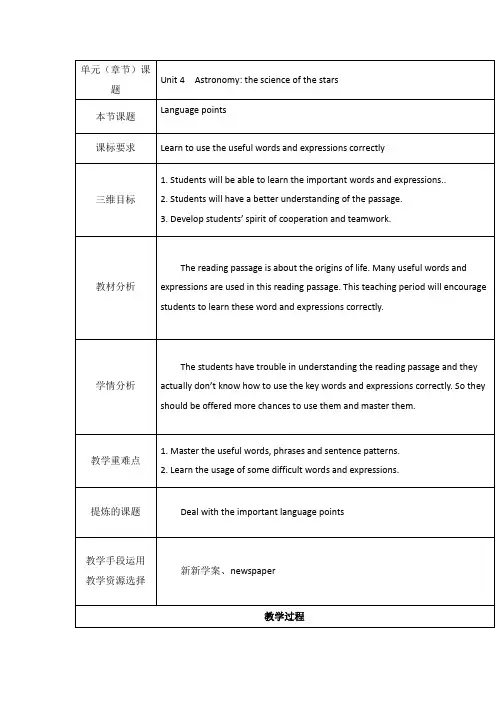
精美句子1、善思则能“从无字句处读书”。
读沙漠,读出了它坦荡豪放的胸怀;读太阳,读出了它普照万物的无私;读春雨,读出了它润物无声的柔情。
读大海,读出了它气势磅礴的豪情。
读石灰,读出了它粉身碎骨不变色的清白。
2、幸福幸福是“临行密密缝,意恐迟迟归”的牵挂;幸福是“春种一粒粟,秋收千颗子”的收获. 幸福是“采菊东篱下,悠然见南山”的闲适;幸福是“奇闻共欣赏,疑义相与析”的愉悦。
幸福是“随风潜入夜,润物细无声”的奉献;幸福是“夜来风雨声,花落知多少”的恬淡。
幸福是“零落成泥碾作尘,只有香如故”的圣洁。
幸福是“壮志饥餐胡虏肉,笑谈渴饮匈奴血”的豪壮。
幸福是“先天下之忧而忧,后天下之乐而乐”的胸怀。
幸福是“人生自古谁无死,留取丹心照汗青”的气节。
3、大自然的语言丰富多彩:从秋叶的飘零中,我们读出了季节的变换;从归雁的行列中,我读出了集体的力量;从冰雪的消融中,我们读出了春天的脚步;从穿石的滴水中,我们读出了坚持的可贵;从蜂蜜的浓香中,我们读出了勤劳的甜美。
4、成功与失败种子,如果害怕埋没,那它永远不能发芽。
鲜花,如果害怕凋谢,那它永远不能开放。
矿石,如果害怕焚烧(熔炉),那它永远不能成钢(炼成金子)。
蜡烛,如果害怕熄灭(燃烧),那它永远不能发光。
航船,如果害怕风浪,那它永远不能到达彼岸。
5、墙角的花,当你孤芳自赏时,天地便小了。
井底的蛙,当你自我欢唱时,视野便窄了。
笼中的鸟,当你安于供养时,自由便没了。
山中的石!当你背靠群峰时,意志就坚了。
水中的萍!当你随波逐流后,根基就没了。
空中的鸟!当你展翅蓝天中,宇宙就大了。
空中的雁!当你离开队伍时,危险就大了。
地下的煤!你燃烧自己后,贡献就大了6、朋友是什么?朋友是快乐日子里的一把吉它,尽情地为你弹奏生活的愉悦;朋友是忧伤日子里的一股春风,轻轻地为你拂去心中的愁云。
朋友是成功道路上的一位良师,热情的将你引向阳光的地带;朋友是失败苦闷中的一盏明灯,默默地为你驱赶心灵的阴霾。
职业高中英语第三册第四单元阅读部分教案unit4readingandwriting汨罗市职业中专学校教学方案设计(首页)教学内容Book3 Unit4 I’ll have tohave my watch replacedReading andwriting(PPT16-28)课型学时节次授课班级授课日期出勤情况纪律情况教学目的知识与技能过程与方法情感态度价值观语言技能目标:听—能够顾客投诉时描述的问题和对问题处理的需求。
说—能够使用典型的句子等描述问题并寻求解决方法。
读—能读懂投诉及处理投诉的信件,能从信件中提取对问题的解决办法。
写—能回复顾客的投诉信学生能在学习中发现问题和解决问题1、小组合作法2、情景教学法3、游戏教学法4、探索发现法文化意识:掌握在工作中遇到投诉时的合理处理方式。
情感态度:学生具备初步的服务意识,能够以专业的方法对待顾客投诉。
教学重点能够听懂顾客投诉时描述的问题和对问题处理的需求。
能够使用正确的句子等描述问题并寻求解决方法教学难点能理解because,since,as,for引导从句和so that 引导从句在句子中不同作用。
能使用because,since,as,for,so that 表达原因和结果教学资源多媒体教学后记Step 1 Review1.请学生在默写上节课所学习的单词。
2.请几组学生表演Activity 6的对话3.检查学生完成Activity 8的练习作业。
Step 2 Lead—inEveryday EnglishIt’s not what you promised. 这与你们承诺的不一致。
How do you expect us to solve the problem?您希望如何解决呢?Can you provide …?您能提供?吗?Contact us again if you have any other problems. 如再有问题请与我们联系。
课题序Unit 4 (1)授课班级号授课形Reading授课日期式授课章Unit 4 If you receive a complaint 节名称使用教教材板书投影仪录音具教学目. 1. Help students improve the skill of proofreading.的Students get the proper strategies of writing a complaint & adjustment letter教学重be able to command the sentence patterns.点2. Help students improve the skill of proofreading教学难Help students to get the proper strategies of writing a complaint & adjustment letter.点教学方小组谈论法教授法知识中心拓展法更新、补充、删根本一致节内容教学后记授课大纲或板书设计Task1 Complain the awful holidayStep2 Learning the dialogue,Master the details of the complaint.have trouble doing sth 有困难做某事get through to接通,使理解put through接通,完成课堂授课安排授课环节教法授课主要内容与过程及时间分配运用第一步:组织授课〔3’〕第二步:复习导入〔10’〕Task1 Complain the awful holidayGive students picture ,and tell them the true traveling experiences that I had last national them Choose the rightpicture according to the expressions,Then we talk aboutwhen we meet these situation we’ ll look for custom service.Step2 Learning the dialogue,Master the details of thecomplaint.Task1 : ListeningListen to the conversation and circle what it is mainly about.a. Problems with a machine.b. How to use a newly bought machine.c. Pricing of a machine.Step2 Learning the dialogue ,aster the details of the complaint. Important phrases:提问板书学生谈论have trouble doing sth 有困难做某事get through to接通,使理解put through接通,完成have problems with有问题cut out停止as if好似,忧如under warranty在保修期Task3 Understanding and acting.Read the dialogue again, talk the difficult points and课堂授课安排授课授课主要内容与程及分配第三步:language points with your partner. (group work)Task4 Finish the exercise讲解新课Task5 Make the ConclusionFind the right answers and match them〔60’〕, I’ m sorry about that..’ ve got a bit of a problem here, you see ⋯3I’m afraid the manager isn ’t in at the moment., could you calllater4Well, I’ m afraid there is nothing we can do about it actually.5I can’ t tell you how sorry I am.6I wish it never happened.7I’m afraid I have to make a serious complaint.8I suggest you leave it with us and we ’ ll see what we can do.9I’ m so sorry, I didn ’ t realize.10Look, I’ m sorry to trouble you, but ⋯11I’ m afraid we can ’ t help you at the moment ⋯板书学生谈论拓展谈论讲解教法运用提问谈论演示第四步:12Well, I’ m afraid there isn ’ t much we can do about it.举例13Excuse me, there seems to be something wrong with ⋯14 Oh, I’ m sorry about that总结〔15’〕 Step 3Further discussion If you receive thecomplaints The awful holiday:When I reach the scenic spot(景区〕 , I found I can’t getthe ticket immediately.Apology:______________________________Action:________________________________ (wait inline ;add some assistants)第五步:REVIEWNEW WORDS作业〔2〕。
外研版新教材必修三Unit4Amazing artPeriod2 Using languages (Grammar & Vocabulary& Listening)教学设计
教材中本课主要内容分为三个部分,即语法、表达(词汇)和听力。
语法部分主要是现在进行时的被动语态。
通过观察课文句子、改写句子练习帮助学生更好地理解该知识点,使印象更加深刻,从而在日后学习中能灵活使用。
表达(词汇)部分是向学生介绍我国传统艺术形式。
此外,通过该练习还可帮助学生提高听力技巧,使学生在实际文本中提高语言的理解能力。
1.语言技能目标
(1)学生能够借助关键词,在理解文章大意的基础上,找出段落主题句,完成读前问题;
(2)用所学的词汇和语言的对课文进行复述;
(3)能够读懂细节信息并能理解阅读中生词含义。
2.语言知识目标
(1)能够正确运用一下单词和短语: neighbourhood, embroidery, seal, seal cutting, calligraphy, porcelain, demonstrate, vividly, needle, elegant, carve, contemporary, cigarette, lack, stimulate等。
(2)能够理解文章中长难句并准确翻译。
3.文化意识目标
(1)了解我国传统艺术相关话题;
(2)了解人们对我国传统艺术形式的理解和态度。
4.情感态度目标
正确认识我国传统艺术形式,以及思考如何能够积极地为社会、人类做贡献。
1.理解文章逻辑关系及架构,理解文章写作意图;
2.引导学生讨论对我国传统艺术形式的理解和感受。
汨罗市职业中专学校教学方案设计(首页)
教学内容Book3 Unit4 I’ll have to
have my watch replaced
Language in
use(PPT29-41)
课型
学时
节次
授课班级授课日期
出勤情况纪律情况
教学目的
知识与技能过程与方法情感态度价值观语言技能目标:听—能够
顾客投诉时描述的问题和
对问题处理的需求。
说—能够使用典型的句子
等描述问题并寻求解决方
法。
读—能读懂投诉及处理投
诉的信件,能从信件中提
取对问题的解决办法。
写—能回复顾客的投诉信
学生能在学习中发现
问题和解决问题
1、小组合作法
2、情景教学法
3、游戏教学法
4、探索发现法
文化意识:掌握在工
作中遇到投诉时的合理处
理方式。
情感态度:学生具备初
步的服务意识,能够以专
业的方法对待顾客投诉。
教学重点能够听懂顾客投诉时描述的问题和对问题处理的需求。
能够使用正确的句子等描述问题并寻求解决方法
教学难点能理解because,since,as,for引导从句和so that 引导从句在句子中不同作用。
能使用because,since,as,for,so that 表达原因和结果
教学资源多媒体教学后记
Step 1 Review
1.请同学背诵Everyday English的句子。
2.请学生朗读自己所写activity 14 的信件。
Step 2 lead -in
Grammar focus
1).I’ll have to have my watch fixed because there is something wrong with the alarm.
2).Would you please show me your receipt so that I can take down some details?
3).Since we have been partners for so long, I have already found a solution to this problem.
4).The assembly line of our company broke down so that we couldn’t fini sh it in time.
5).As we have signed the contract, we will pay for your loss.
1.学生自己阅读例句
2.在教师的引导下发现黑体部分的特点。
Step 3 presentation
通常我们在描述一件事情的时候需要介绍清楚事情发生的时间、地点、原因或条件等。
如果这些信息比较简单,可以用单词或短语进行描述;如果复杂,我们就需要用一个句子来表达。
Eg:Since / as we have no money,we can’t buy it. 由于我们没钱,我们无法购买它。
She didn’t go to bed until she had reviewed Her lessons. 她温习了功课以后才去就寝的。
When I leave school ,I will go where I am needed. 毕业后,哪里需要我,我就到哪里去。
1.原因状语从句用以表示导致主句中的动作或事件发生的原因。
原因状语从句通常由because,as ,since,for引导。
其中because 语势最强,since次之,as又次之。
because 通常表示未知的原因,回答why 提出的问题,而since 和as 则表
示已知原因。
Eg:I didn’t go,because I was afraid.我没去,因为我害怕。
Because he was a man of principle,he was respected even by his opponents.他是个讲原则的人,就连反对他的人也尊敬他。
As he was ill , Mr Fox had cancelled the appointment. 福克斯先生生病了,他取消了约会。
Why have you arrived so late? 你为何迟到?Because the plane was held up by bad weather. 因为航班由于天气恶劣被延误了。
注:连词for 和because 都可表示因果关系,但for 与because有所不同。
for 分句通常只用于正式语体,而because 分句的使用范围较广;就句中的位置来说,because 分句的位置较灵活,而for 分句通常只出现在句尾。
2)目的状语从句用于表达做某事的目的,常由so that,in order that连接,如:
So that they wouldn’t miss the train,the students got up very early.为了不误火车,学生们起得很早。
In order that he would not catch cold, the boy was warmly dressed. 为了不致受凉,孩子们穿得暖暖和和的。
Step 4 Practice and consolidation
Activity 15 underline and group 标出与上面框中黑体字结构相同的部分,并将其归类。
1)I attended an English course so that I could improve my speaking.
2)He looks tired and sleepy because he stayed up very late last night.
3)Since he can’t answer this question, we’d better ask someone else
4)We are here to tell you the good news.
5)He got a prize for finding the most mistakes.
Words or Phrases for Purpose
Words or Phrases for Reason
Activity 16 Read and complete 仿照例子用“because,since,as”或“so that”将下列每组句子组成一句。
Eg:Jane is very confident about getting this job。
She has a lot of work experience.
→ As she has a lot of work experience, Jane is very confident about getting the job.
1)Everybody stayed under the tree.
It was very hot last night.
____________________________________________________ 2)The boy couldn’t draw money from the ATM.
He forgot the pin.
____________________________________________________ 3)Nobody wants to be his partner.
He often delays his work.
____________________________________________________ 4)They all passed the exam.
They would get the certificate.
____________________________________________________ Activity 17 look and complete. 看图,根据图片内容补全故事。
David went to the bookstore today ___________________________ __________. He asked the staff to exchange the MP4 player for him ____________________________________________________. The stuff asked him to show his receipt __________________________________. Then she asked David to wait for a moment ________________________ ______________________________. David was very happy and gave thanks to the staff ________________________________.
1.教师指导学生看图,阅读框中的句子。
2.学生两人一组讨论,补全短文。
3.教师请几名同学朗读短文并给出反馈。
Step5 homework
1.完成练习册的练习
2.阅读书本上life and culture 的文章。
教师可引导学生先理解每幅图片的内容,然后再将五幅图片的内容连起来,之后再进行短文写作。